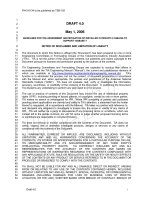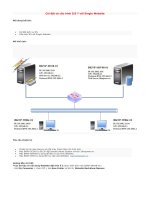MOB Subject 7 –IEEE 802.11 standards Wifi performances
Bạn đang xem bản rút gọn của tài liệu. Xem và tải ngay bản đầy đủ của tài liệu tại đây (224.67 KB, 8 trang )
Master of Computer Science 1 - MOB Mobile Internet and Surrounding
Fladenmuller Baey - ”IEEE 802.11standards” 1/8
MOB Subject 7 –IEEE 802.11 standards
Wifi performances
1. Impact of the transmission quality
One is interested here in the impact of radio transmission errors on the performances of a
wireless network and in the relation between transmission and fragmentation quality. One takes
here the standard IEEE 802.11b as an example.
1. Let p be the binary error probability on a communication channel used by a local network
and n be the length of a physical frame in bytes. What is the error probability q on a frame?
It will be supposed that the errors on the bits are independent.
A. N. : p = 10
-6
, n = 2370 bytes (maximum length of a MAC frame in conformity with the
802.11 standard (2346 bytes) + PHY header of 24 bytes).
A frame is error just if any bit has undergone a transmission error. The corresponding
probability can be written: (1 p)
8n
The probability of error per frame can be written thus:
q = 1 – (1 – p)
8n
= 0,018781399
2. For an error probability q per frame, determine the average number N of transmissions has
to effect to succeed the correct transmission of a frame? For the digital application, one will
take p = 10
-6
.
Reminder: 1 + 2q + 3q
2
+ … + iq
i-1
+ … =
)1(
1
2
q
The probability that a frame need to be exactly i transmissions correctly transmitted can be
written: p(i) = q
i – 1
(1 – q)
The average number of transmissions necessary to succeed a correct transmission is written
so:
])1(1[1
1
1
1
)1(
1
)1()1()(
82
11
n
ii
p
q
q
q
iqqqiqiipN
0191,1
)1(
1
8
n
p
3. One wants to make a first coarse evaluation of the bit rate lost because of the
retransmissions on error. One thus does not take any other factor in account but the errors of
transmission. One supposes in first approximation that all bits of the physics frame are send
with the same flow.
a) For a error probability per frame q and a nominal capacity d of transmission, what is the
useful bit (goodput) and what is the lost flow at the time of the retransmissions for a
channel which is used permanently (there is always a frame to transmit i.e. is the
channel is saturated)?
A. D. : d = 11 Mbit/s and p = 10
-6
.
Master of Computer Science 1 - MOB Mobile Internet and Surrounding
Fladenmuller Baey - ”IEEE 802.11standards” 2/8
The useful throughput is written:
Mbpspd
p
d
N
d
G
n
n
8,10)1(
)1(
1
8
8
The lost throughput during broadcasts can be written:
)
1
1(
N
d
or 0.2 Mbps
b) The same question that previously if one takes the header MAC + PHY of length l
e
equal
to 58 bytes into account (24 bytes of header PHY + 34 bytes of header MAC).
Length of the field data of a frame: l
d
Length of the MAC + PHY header of a frame: l
e
Total length of a frame: n = l
d
+ l
e
With these notations, useful throughput is written now (by reasoning on a frame):
Mbpspd
p
d
N
d
G
n
n
53,10)1(
)1(
1
8
8
4. The wifi standard 802.11 envisages a functionality of fragmentation on the MAC level.
Suppose that one splits up the contents of a physical frame of n bytes in k fragments (that
one will suppose all of identical size) before to send it, and that like previously one does not
take any another factor into account but the transmission errors. What becomes the useful
bit?
A. N.: d = 11 Mbit/s, length of the frame n = 2370 bytes, k = 4 fragments and p = 10
-6
.
Length of the field data of a frame: l
d
Length of the MAC + PHY header of a frame: l
e
Total length of a frame: n = l
d
+ l
e
Data field length of a fragment: l
f
Total length of a fragment: L
f
= l
f
+ l
e
=
e
e
l
k
ln
With these notations, useful throughput is written now (by reasoning on a fragment):
e
e
ff
l
k
ln
e
e
e
L
f
e
L
pd
l
k
ln
k
ln
pd
kL
ln
pd
sentbitstotalnb
usefullbitsnb
G
8
88
)1()1()1(
= 9,81Mbps
5. Split up the frames in small fragments increasingly to improve the useful bit is not possible.
What are the different factors which limit the use of the fragmentation in the wifi networks
802.11 to deal with the errors problem?
For a given BER, the transmission rate decreases as frame size decreases. Nevertheless, the
flow is useful in parallel DECREASE beyond a certain threshold as the proportion of bits
used by the control (overhead of headers) will increase relative to the flow useful ...
2. Theoretical maximum flow of 802.11b
Master of Computer Science 1 - MOB Mobile Internet and Surrounding
Fladenmuller Baey - ”IEEE 802.11standards” 3/8
Hypothesis:
- inter-frame interval to distributed access (DIFS) 802.11b: 50 µs
- hard copy of a back-off between 0 and 31 intervals of time
- duration of a time interval: 20 µs
- physical overhead: the transmission of each frame must be preceded of a "long"
preamble of 192 bits transmitted to 1 Mbit/s or of a "short" preamble of 72 transmitted
bits to 1 Mbit/s followed by 48 bits transmitted to 2 Mbit/s.
All the equipment in front of must implement the long preamble; this is that which we
retain here.
- inter-frame short interval (SIFS) of 802.11b: 10 µs
- data volume to transfer: 1500 bytes
1. It is supposed that the data flow is fixed of 1 Mbit/s. Determine the efficacy of channel with
and without the RTS/CTS mechanism. It is estimated that no frame is lost.
See table below. Result: 1880 µs.
Figure 1: Format frame PHY layer of IEEE 802.11b (bits).
Figure 2: Format frame given sueh MAC layer of IEEE 802.11 (in bytes).
Table: Calculation of time sending and acquittal of 1500 bytes of data with 802.11b.
2. When the RTS/CTS mechanism is not implemented, it is estimated that only the date frames
can be lost. When it is implemented, only RTS frames can be corrupted. 20 µs are needed to
detect the frame absence (CTS or ACK), after which a DIFS delay is introduced. Calculate
the probability p of frame loss from which the RTS/CTS mechanism is advantageous. One
will suppose p
2
negligible.
number of bits in length and µs Total and µs
DIFS 50
back-off
Average = 15,5 20 µs
310
overhead PHY 192 bits and 1 Mbit/s 192
overhead MAC 2 + 2 + 6 + 6 + 6 + 2 + 6 + 4 = 34 octets =
272 bits and 11 Mbit/s
25
data 1500 octets = 12000 bits 1091
SIFS 10
overhead PHY 192
ACK 14 octets = 112 10
Total 1880
Master of Computer Science 1 - MOB Mobile Internet and Surrounding
4
3. Environment heterogeneity
1. If two clients share the access point, one working in 11 Mbit/s and the other in 1 Mbit/s,
what is the average flow of the access point, in considering that the supervision occupies
the half time of the access point? The size of the frames and their quantity is the same for
the two terminals.
Sharing media is handed manner between the two terminals. The overall flow of the access
point is determined by the throughput of each client and the time during which they
transmit. He who emits a 1 Mbps generally require 11 times longer than that emits a 11
Mbit/s. The issuance of a frame has 1 Mbit/s lasts 11 times longer than the issuance of a
frame at 11 Mbit/s.
Time frame for issuance of an x bits with 1 Mbit/s and with 11 Mbit/s (in s):
Rappel mathematical:
A discrete random variable is a random variable that takes a number countable assets. The
law of probability of a random variable X is given by { P (X = x), x value taken by X }.
Let X be a discrete random variable. Called expectation of X and we denote by E (X) the
quantity E (X) =
x)(XxP
. The summation is over all values taken by X. The
expectation of the random variable is interpreted as its value average.
Fixes:
Time lost due to poor transmission of data:
T
totalData
= TDIFS + TBO + TrData + TSIFS + 20 µs + TDIFS = 12904 µs
(it takes 20 µs to detect the absence of ACK)
Time lost due to poor transmission of RTS:
T
totalRTS
= TDIFS + TBO + TrRTS + TSIFS + 20 µs + TDIFS = 792 µs
The transmission time of a frame without error is given in the question precedente. The average
transmission time of one frame is written thus:
Without RTS/CTS:
T(µs) = (1 – p) 13138 (no retransmission)
+ (1 – p) p (T
totalData
+ 13138) (1 retransmission)
+ (1 – p) p
2
(2T
totalData
+ 13138) (2 retransmission)
+ ...
= 13138 + 12904 p by neglecting the terms p
2
.
With RTS/CTS:
T’(µs) = (1 – p) 13814 (no retransmission)
+ (1 – p) p (T
totalData
+ 13814) (1 retransmission)
+ (1 – p) p
2
(2T
totalData
+ 13814) (2 retransmission)
+ ...
= 13814 + 792 p by neglecting the terms p
2
.
T = T’ if p = 5,58%.
Master of Computer Science 1 - MOB Mobile Internet and Surrounding
Fladenmuller Baey - ”IEEE 802.11standards” 5/8
x
x
x
11
12
11
Average speed =
6
11
11
12
2
x
x
=1,83 Mbit/s
If the party oversight occupies 50% of the time the access point, the flow is more than 0,9
Mbit/s.
In reality, if the party holds 50% of monitoring the bandwidth to 11 Mbps, it is
proportionally much less than a 1 Mbit/s. The real flow would be superior to 1 Mbps.
2. Which solution would you recommend to maintain a high flow in the cell?
Two solutions:
- Disconnect customers who do not work at 11 Mbit / s. This solution would oblige the
operators of hotspots has increased the number of access points.
- Limiting the access time of the slowest client. Thus, if customers the slowest can take
only half the time in emission,...
3. If a Wifi card could automatically adapt its emission power to reach the access point,
would that lengthen the lifespan of its batteries?
Yes, it would be more obligated to emit at full power all the time. It is nevertheless the
power is sufficient to avoid falling in the previous problem and be able to emit a maximum
throughput. There is no control of dynamic power provided for in the standard.
4. Let a wifi network be working with the flow of 11 Mbit/s. The access cards is the same that
the access point can adapt their emission power.
a) If one has decreased the transmission power of the access point, what would be the
impact on the cell size?
Decrease in the size of the cell.
b) Show that one would need much more access points to cover the same territory?
Over the cell is smaller, it requires more access points.
c) Does one thus increase the total capacity of the network?
Yes, the applications as a same frequency can be reused more often.
d) Is the mobility reduced?
802.11 does not define how to implement the changes Intercel-lular, handovers in
English. The standard defines the functions of association and disassociation has an
access point that can be used to establish the mechanisms of handovers, but it does
not define the signaling between the access points, at least without the standard
802.11f . The implementation of beneficial handover requires a system of signs that
would be even more sophisticated than these handovers are many (many linked to
the cell size). There are currently versions owners (CISCO) which set up a signal.
We can therefore say that mobility is more limited with small cell sizes.









